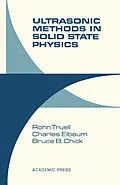Ultrasonic Methods in Solid State Physics is devoted to studies of energy loss and velocity of ultrasonic waves which have a bearing on present-day problems in solid-state physics. The discussion is particularly concerned with the type of investigation that can be carried out in the megacycle range of frequencies from a few megacycles to kilomegacycles; it deals almost entirely with short-duration pulse methods rather than with standing-wave methods.
The book opens with a chapter on a classical treatment of wave propagation in solids. This is followed by separate chapters on methods and techniques of ultrasonic pulse echo measurements, and the physics of ultrasonically measurable properties of solids.
It is hoped that this book will provide the reader with the special background necessary to read critically the many research papers and special articles concerned with the use of ultrasonic methods in solid state physics. The book is intended to help the person beginning work in this field. At the same time, it will also be useful to those actively involved in such work. An attempt has been made to provide a fairly general and unified treatment suitable for graduate students and others without extensive experience.
Inhalt
Preface
Introduction
Chapter 1. Propagation of Stress Waves in Solids
1. Introduction
2. Stress, Strain, and Displacement Relations
3. Equations of Motion and Solutions
4. Propagation Directions and Velocities
5. Energy and Energy Flux
6. Scattering Relations
7. Orientation Dependence of Stress Waves in Single Crystals
8. Explicit Expressions for Fractional Velocity Change as Function of Misorientation for Several Crystal Systems
9. Some Numerical Results for Misorientation Effects in Cubic Crystals
10. Energy Flux Associated with Stress Waves
11. Stress Waves in Piezoelectric Crystals
12. Nonlinear or Anharmonic Effects
Chapter 2. Measurement of Attenuation and Velocity by Pulse Methods
13. The Pulse Echo Method
14. Definitions of the Attenuation a, of the Decrement d, and of the Dissipation Q
15. Methods of Measuring Attenuation
16. Coupling with Two Transducers (through Transmission)
17. Coupling Losses
18. Velocity Measurements
19. Systems for Velocity Measurements
20. Measurement Losses
21. Diffraction Losses
22. Nonparallelism and Wedging Effects
23. Effects of Wedging of Elastic Properties
24. The Spectrum Analyzer and Its Uses
25. Specific Application of the Spectrum Analyzer: Factors Affecting the Spectrum
26. Attenuation Equipment Considerations
27. Velocity Equipment Considerations
28. Microwave Ultrasonic Equipment
Chapter 3. Causes of Losses and Associated Velocity Changes
29. Introduction to Loss Interactions
I. Scattering
30. Statement of the Problem
31. Scattering Cross Section and Attenuation
32. Calculation of Scattering Cross Sections
33. Numerical Calculations of Scattering Cross Sections
34. Multiple Scattering and Scattering Density
II. Thermoelastic Effects
35. Physical Description of the Effect
36. Phenomenological Analysis
37. Attenuation and Velocity Changes Due to the Thermoelastic Effect
38. Calculations for Cubic and Hexagonal Crystals
III. Dislocation Damping
39. Description of the Model for Dislocation Damping
40. Equations of Motion and Solutions
41. Attenuation and Velocity
42. Distribution of Dislocation Loop Lengths
43. Strain Amplitude Effects
44. Thermal Effects in Dislocation Damping
45. Anomalous Ultrasonic Velocity Effects Associated with Dislocation Behavior
46. The Generation of Harmonics in Crystalline Solids Due to Dislocations
47. Some Selected Experimental Results
48. Bordoni Peaks
49. The Kink Model of Dislocation Damping
IV. Magnetoelastic Interactions
50. Stress Wave Interaction with Magnetic Domain Walls: Experimental Results
51. Outline of an Analytical Approach to Domain Wall Motion
52. Interaction of Spin Waves and Ultrasonic Waves in Ferromagnetic Crystals
53. Experimental Observations concerning Spin Waves and Ultrasonic Waves
V. Stress Wave Interaction with Conduction Electrons in Metals
54. Conditions for Interaction
55. More Complete Classical Interpretation
56. Quantum-Mechanical Interpretation
57. Influence of Magnetic Field
58. Application to Fermi Surface Study
59. Application to Superconductivity Study
VI. Ultrasonic Stress Wave Interaction with Thermal Waves: Phonon-Phonon Interaction
60. Description of the Problem
61. Experimental Situation
62. Theoretical Situation and Calculation of Attenuation
VII. Stress Wave Interactions with Nuclear Spin Systems
63. Preliminary Remarks
64. Conditions for Interaction
65. The Ultrasonic Attenuation Coefficient
66. Coupling through the Dynamic Electric Quadrupole Moment
VIII. Stress Wave Interaction with Electron Spins of Paramagnetic Centers
67. Stress Waves and Electron Spin Level Transitions
IX. Stress Waves and Electrical Phenomena in Piezoelectric Crystals
68. Wave Propagation in Piezoelectric Semiconductors
69. Light-Sensitive Ultrasonic Attenuation in CdS
70. Ultrasonic Amplification in CdS
X. Acoustoelectric Effect in Semiconductors
71. General Description
Appendix A. Elastic Constants of Trigonal Crystals (Al2O3)
Appendix B. Fractional Velocity Changes and Eigenvectors Associated with Section 8
Appendix C. Sample Preparation, Transducer and Bond Considerations
Appendix D. Some Useful Physical Constants for Various Crystalline Solids
Appendix E. Automatic Attenuation Measurement System
Appendix F. Automatic Time Measurement System
Appendix G. Evaluation of Coefficients in Scattering Cross Section for Transverse Waves
Appendix H. Numerical Computation of Normalized Cross Sections yN
Appendix I. Method of the Boltzmann Transport Equation
Appendix J. Quantum-Mechanical Treatment of Attenuation by the Three Phonon Process
References
Author Index
Subject Index
